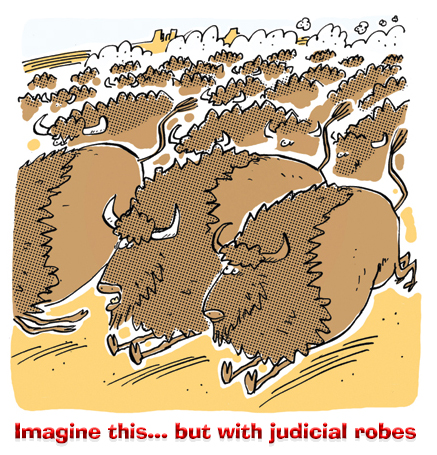We post news and comment on federal criminal justice issues, focused primarily on trial and post-conviction matters, legislative initiatives, and sentencing issues.

TWO MORE CIRCUITS REJECT GUIDELINES § 1B1.13 AS GOVERNING COMPASSIONATE RELEASE
 Since United States v. Brooker last fall, four other circuits had held that USSG § 1B1.13, the Guidelines policy statement that severely restricts qualification for 18 USC § 3582(c)(1)(A)(i) compassionate release, did not apply to motions brought by inmates.
Since United States v. Brooker last fall, four other circuits had held that USSG § 1B1.13, the Guidelines policy statement that severely restricts qualification for 18 USC § 3582(c)(1)(A)(i) compassionate release, did not apply to motions brought by inmates.
Last week, the 5th and 9th Circuits joined the stampede, bringing the total to seven.
The Guideline, among other terms, requires movants to show that they will not be a danger to the community or others (applying the standards of 18 USC § 3142(g), the statute governing pretrial release), and limits compassionate release for inmate medical conditions, sick partners, unparented kids. Other reasons may be used as well, but only those approved by the BOP.
It is hard to overstate the importance of the tsunami of holdings invalidating the use of §1B1.13 in compassionate release cases. District courts have cited § 1B1.13 in over 7,200 decisions in the last year. The government continues to argue in pleading that courts should reject compassionate release motions as inconsistent with § 1B1.13, even where the circuit has held otherwise. Just last week, I read a compassionate release response in which the government reluctantly acknowledged – almost as an afterthought – that the Circuit had held that nothing “in the now-outdated version of Guideline § 1B1.13 limits the court’s discretion,” but only after a full page of arguing the court should apply it anyway.
Francesk Shkambi’s compassionate release was thrown out by a district court for lack of jurisdiction, because Frank didn’t fit into any of the four grounds listed in § 1B1.13. But last week, the 5th Circuit reversed, finding § 1B1.13 inapplicable:
§ 1B1.13 says it only applies to ‘motion[s] of the Director of the Bureau of Prisons’. That makes sense because in 2006 (when the Sentencing Commission issued the policy statement) and in November of 2018 (when the Commission last amended it), the BOP had exclusive authority to move for a sentence reduction. When Congress enacted the First Step Act in December of 2018, it gave prisoners authority to file their own motions for compassionate release; but it did not strip the BOP of authority to continue filing such motions on behalf of its inmates. So the policy statement continues to govern where it says it governs — on the ‘motion of the Director of the Bureau of Prisons.’ But it does not govern here — on the newly authorized motion of a prisoner… Just as the district court cannot rely on a money-laundering guideline in a murder case, it cannot rely on the BOP-specific policy statement when considering a non-BOP § 3582 motion.
 Meanwhile, in California, a district court denied Pat Aruda’s compassionate release motion because it was inconsistent with § 1B1.13. Last week, the 9th Circuit reversed.
Meanwhile, in California, a district court denied Pat Aruda’s compassionate release motion because it was inconsistent with § 1B1.13. Last week, the 9th Circuit reversed.
We agree with the persuasive decisions of our sister circuits and also hold that the current version of USSG § 1B1.13 is not an ‘applicable policy statement’ for 18 USC § 3582(c)(1)(A) motions filed by a defendant,” the Circuit wrote. “In other words, the Sentencing Commission has not yet issued a policy statement “applicable” to § 3582(c)(1)(A) motions filed by a defendant. The Sentencing Commission’s statements in USSG § 1B1.13 may inform a district court’s discretion for § 3582(c)(1)(A) motions filed by a defendant, but they are not binding.
So far, the 2nd, 4th, 5th, 6th, 7th, 9th and 10th have ruled that § 1B1.13 does not control inmate-filed compassionate release motions. No circuit has held otherwise.
United States v. Shkambi, Case No 20-40543, 2021 US App. LEXIS 10053 (5th Cir. Apr 7, 2021)
United States v. Aruda, Case No 20-10245, 2021 US App. LEXIS 10119 (9th Cir. Apr 8, 2021)
– Thomas L. Root

